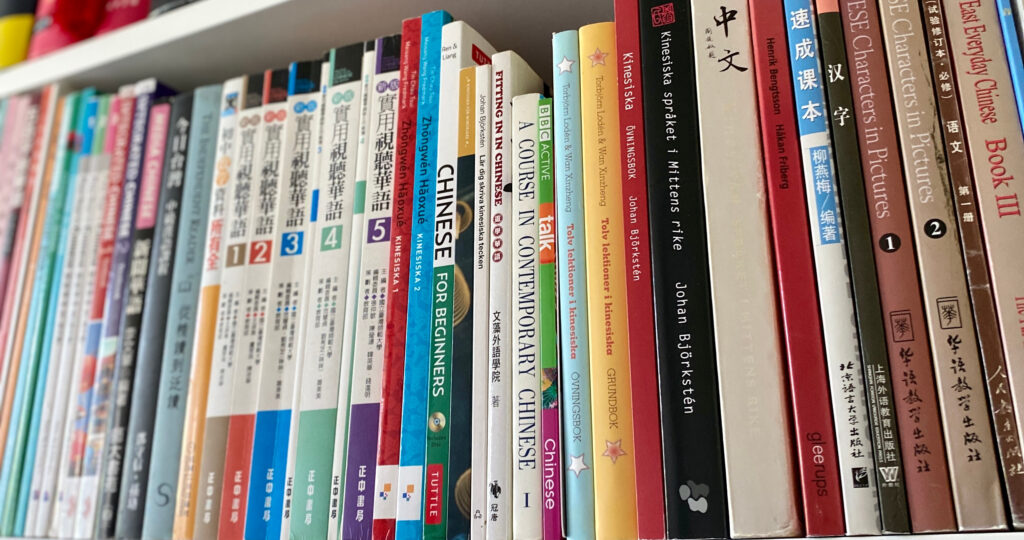
Whether you’re learning Chinese on your own or are taking a course, textbooks can be useful resources, especially when you start out. They serve you the most important words and sentence patterns, put them in a meaningful context, and provide you with with basic input in the form of listening and reading. They also tell you you basic things about the language that might be useful to know.
However, textbooks also have serious drawbacks. As I discussed in Analyse and balance your Chinese learning with Paul Nation’s four strands, a balanced diet of Mandarin should contain mostly meaning-focused activities. For something to be meaning-focused, the language and content need to be familiar to a high degree, preferably 95% or more. This disqualifies the texts in all major textbooks series available, as they contain far more new content than that. Other activities, such as textbook exercises, are also disqualified because they rarely focus on meaning.
Tune in to the Hacking Chinese Podcast to listen to the related episode:
Available on Apple Podcasts, Google Podcast, Overcast, Spotify, YouTube and many other platforms!
As I also said in that article, language-focused learning shouldn’t take up more than 25% of your studies, but if you follow a standard curriculum using a standard textbook, you’re likely to spend almost all your time with language-focused activities. The activities I just said don’t count as meaning-focused are all examples of language-focused activities, and sometimes bad language-focused activities at that.
The only part of a standard textbook that might count as anything else is unit-final extra reading and listening, where the textbook authors recycle everything you have learnt throughout a unit. This extra content is great, but is woefully inadequate.
This doesn’t mean that textbooks are useless for learning Chinese, however, but it does depend on how you use them. Let’s first have a look at what one textbook can do for you, before we move on to the benefits of using more than one textbook. I will start by talking about textbooks for beginners and then continue to more advanced learners later in the article.
A textbook introduces useful language in context and explains how it works
Here are a few reasons what you can get from a single textbook:
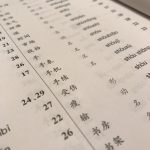 Textbooks contain language that is common and useful for students. This selection is valuable, because the authors’ guesses are better than most, and they also avoid overly complicated language that would be a waste of time at your current level. Thus, anything you find in a beginner textbook can be counted on being useful. Naturally, it’s rarely a good idea to study words from a list, but most textbooks do a decent job of integrating words in dialogues and texts. If you’re a beginner, this is very important, as this is often your only chance of being able to make sense of any Chinese.
Textbooks contain language that is common and useful for students. This selection is valuable, because the authors’ guesses are better than most, and they also avoid overly complicated language that would be a waste of time at your current level. Thus, anything you find in a beginner textbook can be counted on being useful. Naturally, it’s rarely a good idea to study words from a list, but most textbooks do a decent job of integrating words in dialogues and texts. If you’re a beginner, this is very important, as this is often your only chance of being able to make sense of any Chinese.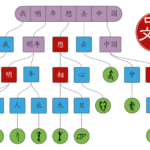 Textbooks explain how Chinese works. This is not necessary when children learn languages, but understanding roughly what’s going on is helpful more helpful for adult learners. This is especially true if you don’t have someone who’s willing to talk to you all the time in level-adjusted Chinese, spoon-feeding the input you’d need to figure out things for yourself. A good example of this is that having a basic understanding of how characters work make the easier to learn. Still, don’t confuse learning about words and grammar with actually being able to use them. Chinese is best learnt implicitly through exposure with only a seasoning of explicit instruction.
Textbooks explain how Chinese works. This is not necessary when children learn languages, but understanding roughly what’s going on is helpful more helpful for adult learners. This is especially true if you don’t have someone who’s willing to talk to you all the time in level-adjusted Chinese, spoon-feeding the input you’d need to figure out things for yourself. A good example of this is that having a basic understanding of how characters work make the easier to learn. Still, don’t confuse learning about words and grammar with actually being able to use them. Chinese is best learnt implicitly through exposure with only a seasoning of explicit instruction.
Like I said above, the main problem with textbooks is that none of this counts as meaning-focused learning or fluency development; it’s all language-focused activities. If this is all you do, you’ll regret it later when you realise your Chinese isn’t as good as you think it ought to be.
Why you should use more than one Chinese textbook
A natural follow-up question to the above argument is that if textbooks won’t provide the type of learning you need, what will? While I could talk about immersion (at home or abroad) or comprehensible input, the truth is that as a beginner, it’s difficult to get your hands on Chinese content you can make sens of using your as yet limited understanding of the language. Sure, if you have a great teacher who can help you or find yourself in the perfect learning environment, that will work, but for most people, that’s not a realistic option. Instead, I’ll propose a simpler solution that might sound counter-intuitive at first:
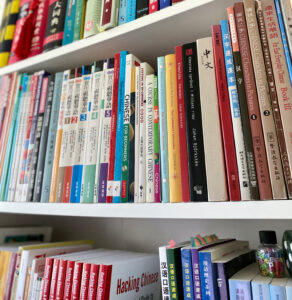 Use more than one textbook!
Use more than one textbook!
Wait, if using one textbook is bad because it contains the wrong kind of practice, wouldn’t using more textbooks make it even worse?
No, it won’t; let me explain.
The main problem with textbooks is that they throw too much new language at you. The problem with not using textbooks at all is that it’s hard to find listening and reading content elsewhere that isn’t even worse in this regard.
Here’s the solution: If you study the first three chapters in a textbook, then put it away and study the first three chapters in a second textbook, most of the words will already be familiar to you because even if textbooks are different, they are not that different. Maybe you won’t get to 95% familiarity, but you probably will when you get to the third textbook.
In practice, you can vary this approach as much as you want. Maybe you only want to study one chapter in the book before you pick up the second and third textbook, maybe you want to study five chapters. Perhaps you have access to lots of textbooks and want to use seven of them. Feel free to experiment!
Which textbooks you use doesn’t matter that much as long as they don’t have horrible text and/or audio. You might want to use the language-focused activities in one of the textbooks you use (probably the first), but for the subsequent textbooks, you’ll only use the text and audio. And by the way, make sure you listen before you read whenever possible! The exercises in most textbooks are terrible, so you can ignore those for the most part anyway. I wrote about which textbooks to use (among other resources) here: The 7 best Chinese reading resources for beginners.
https://www.hackingchinese.com/beginner-chinese-reading/
Additional textbooks are useful for intermediate learners as well
One way of looking at a textbook is to say that it’s your guide to an unknown landscape you find yourself in after parachuting from high altitude. It leads you along a carefully blazed trail of ever increasing difficulty. If you were to draw a map of your learning, the centre is where you landed, and the further away you move, the more difficult the Chinese you encounter becomes. As you follow the guidance of your textbook, you quickly leave the landing point to explore far and distant lands beyond the horizon.
However, you mustn’t fool yourself into thinking that being able to walk a distance in one direction means that you know everything else within the same distance from your starting point. The language landscape is huge and there’s a lot to explore even if you stay close to your starting point. Approaching more difficult challenges doesn’t mean that the easier ones are all mastered. Thus, it’s perfectly possible to finish a whole textbook series that ends with chapters covering complex content, but still be bad at basic conversations. Here’s an image I made to illustrate this point, where green shows the known and white the unknown. On the left, you see the result of following a textbook series and on the right you see the result of an approach that maximises your ability to use and understand Chinese.
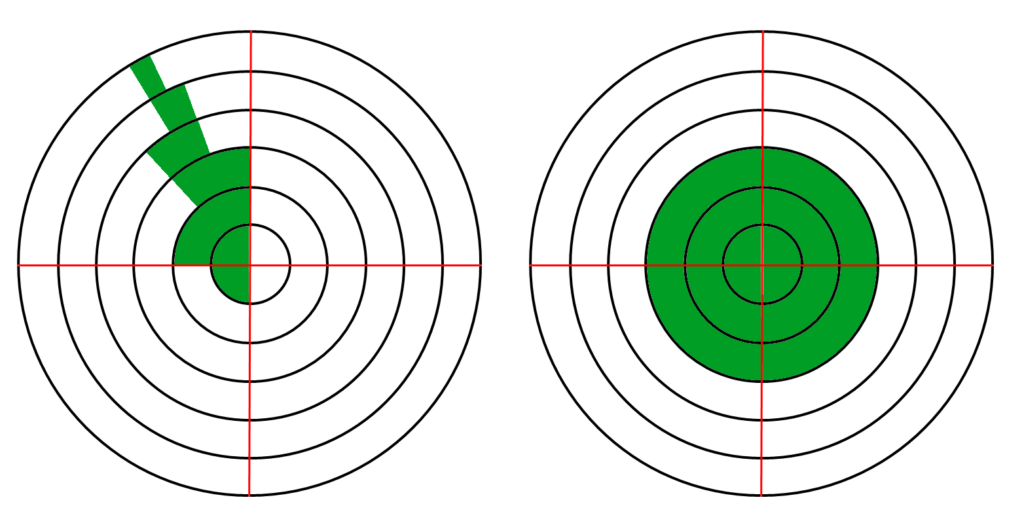
The image is from The illusion of advanced learning and what to do about it if you want to read more about this particular phenomenon.
Additional textbooks solidifies your fundamental knowledge of Chinese
So, how might additional textbooks be used here? If you use an additional textbook, it provides a new and different guided tour through the landscape, which should be at least partly familiar by now. As you can see in the above image, the innermost true beginner circle is very small, but the more you learn, the longer the circumference becomes. As an intermediate learner, you’re unlikely to find that chapters overlap perfectly, but you will see significant overlap, while also benefiting from the areas that don’t overlap.
The vocabulary in each textbook is chosen by different authors with slightly different perspectives, leading to another set of words somebody thinks you really should know. No author can include all words they think are necessary in a single textbook series; they have to select some and omit others, but if you use more than one textbook, you will get a more complete picture. In the image above, using more than one textbooks will make it more likely that a larger area of the inner circles are coloured green.
Let’s illustrate what I mean with a simple example. All standard textbooks I’ve seen cover sports and hobbies in some way, but they all vary in which activities they cover. Some might be written for Americans and cover baseball, others might focus on basketball or something else. In yet a third textbook, the main characters might go swimming instead. By reading several different chapters on a similar level that all cover sports, you strengthen your fundamentals, which is much more important than racing ahead to more complex topics.
In fact, not only textbooks are guilty of this. Word lists for language proficiency exams like the HSK or TOCFL also omit some very high-frequency words or include them but much later than you’d think. I’ve written about this in one article for each test:
Language learning is about more than textbooks
Please note that just because I recommend using more than one textbook here, that doesn’t mean that you should only rely on textbooks for listening and reading practice. As soon as you get past the very basics, you should try to find podcasts and graded readers to further expand your learning. This is a completely different topic, though, and if you want to know what to read and what to listen to, you can check out these two articles:
The 10 best free Chinese reading resources for beginner, intermediate and advanced learners
https://www.hackingchinese.com/the-10-best-free-listening-resource-collections-for-learning-chinese/
Conclusion: You should use more than one textbook
Whether you’re a student or a teacher, I recommend that you use more than one textbook, especially at a beginner and intermediate level. For beginners, textbooks beyond the first one solves the problem of too much unfamiliar content. For intermediate learners, more than one textbook offers breadth rather than introducing too advanced topics too early. Following one single textbook series to the end and not doing much else beyond that is never a good idea, but using a whole range of textbooks at once is great!
Editor’s note: This article, originally published in 2011, was rewritten from scratch in May, 2022.

23 comments
Hi Olle,
I’m still stuck studying Practical Audio Visual Chinese. I’m in Book 3, Chapter 5 and I have been for a long time. My goal is to get to the point where I can listen to the audio track for the dialog and understand it 100%. Then I will go on to the next chapter. It’s a really slow process. I find that reading the dialog is more helpful than listening to the dialog over and over again. I guess my memory works more through the eye than the ear. My intention is to get through Book 3, 4, 5 by the time I go back to Taiwan in the Fall of 2011.
I was wondering what you thought of this approach, to just devote myself to one series of textbook. I also have New Practical Chinese Reader 2, but I find it much less interesting than PAVC. You’re right that you can pick up new vocabulary simply based on the sheer variety in different textbooks. But I would still argue that there is something beneficial about staying true to one textbook and mastering it. My Chinese LE here in Houston told me about a Chinese guy that got a textbook and CD, and forgot about the textbook and just focused on getting the sounds of English from the CD. Apparently he got really good at hearing English and writing down what he heard. I can’t imagine doing that for Chinese. Maybe if Chinese had a script like English, but not for characters.
Hope everything is going well for you.
David
Hi David,
I think staying true to one series of textbooks is a good idea, because if it’s a good series (and Practical Audio-Visual Chinese is good), each books creates a foundation for the coming books, meaning that you spend less time learning things twice and run a lower risk of missing something important because you skip books. I think listening is harder for everyone, because it requires you to understand without having to think to much (you can look at a word for ten seconds, but you can’t listen to a word ten times). I think combined listening and reading is a good idea, perhaps trying to listen a couple of times first and then check what you’ve missed? Then listen again. Keep the old chapters with you on your phone and refresh your memory. I tend to listen to the same radio programmes over and over because it gives me a better understanding.
However, enough of praising repetition for now. I think there lies danger in focusing too much on a very narrow range of teaching materials, such as just one book. I’ve written an article about this, I don’t know if you’ve seen it, but it can be found here. Spend at least some time doing something completely different. Watch TV, listen to music, read another textbook, read comics, anything. And, most importantly, don’t do it with the same mindset as when you read your ordinary textbook! If you like, view it as two types of studying: detail versus broad, in depth versus superficial. Broad and superficial is necessary to build a sense of how the language works, to improve reading speed and listening ability. It might not feel as if you’re improving, but that’s only because it takes very much time to build up your “language feeling” (語感).
Keep it up! Let me know how you’re progressing. 🙂
I completely agree with your advice Olle.
I have been working with the same audio course for the past 8 weeks now.
The last two weeks have been disastrous, my brain just won’t register the dialogues.
My method was to listen over and over and over again until I could understand. I listened first, then listened and tried to understand, listened again while reading, learnt the vocabulary then listened once more. I don’t know how I lasted 6 weeks doing this. Well I’m so fed up I have not done much learning. For the last 2 weeks I have been trying other ways of getting back on the bandwagon, this includes creating my own lessons, trying other books (this has been a positive experience because I can tell that my Chinese reading and comprehension has improved) and of course watching some Chinese language film or drama daily.
One major lesson I have learnt is that my former method was bordering on perfectionism. I tried listened to my audio lessons again today and I knew that I would do so only once. Well, the effect was different. I understood the stuff and I had not put any pressure on myself.
I really felt I was not getting anywhere. I completely agree with ” It might not feel as if you’re improving, but that’s only because it takes very much time to build up your language feeling”. I will stop being so hard on myself and impatient with myself.
Thank you Olle!!
Hi! You highlight some important points here. I think diversity is useful for many reasons and not becoming bored is certainly among the most important reasons. Also, finding a balance between learning new things and mastering (perfecting) old ones is also tricky. I thought that I had written an article about the downside of perfectionism, but it turns out I haven’t. I’ll make sure to add that to the queue, thanks! 🙂
Edit: The article has now been published!
Good Article Olle!
I am following your blog for a while now and really appreciate that you put so much effort in your posts!
Regarding this one – I can’t agree more. I’m forced to use NPCR at my university and consider this textbook as quite a pain in the ass. The dialogues feel somehow artificial, not to mention the videos.
However, I got myself some books of the PAVC series and “Practical Chinese Reading & Writing”, which helped me a lot to enjoy working with NPCR.
加油,
Armin
Good post for people learning Chinese. I think that something that we find very hard when we start learning Chinese is that unlike say Spanish, our Chinese levels in the different disciplines (speaking, reading, writing and listening) can vary vastly. Many of the “comprehensive courses” offered are not necessarily suitable for everyone and don’t necessarily tackle these disciplines in the right order. Ie with a textbook that’s focused on speaking, the characters you learn in that book will not be in order of easiest to write but will be in easiest to say for simple dialogues. Many of the textbooks excel in one area (say speaking) and is less good for the other areas. This is why it’s necessary to get more than one textbook or use more than one learning method (ie textbook for reading and writing and podcasts).
Yes, I agree. In this article I meant that it’s good to use more than one textbook even if we only consider the areas textbooks normally covers (i.e. not podcasts), but it goes without saying that textbooks shouldn’t be our only way of learning. However, it’s great that you point out that different books have different strengths. For instance, in some books, the grammar exercises are either very boring, very bad or both. Another book might have good exercises but lousy explanations and so on.
I completely agree. With Chinese we often get this idea that one textbook can cover everything and this is a very simplistic view, even with the best integrated courses. And that’s the same for grammar, the vast majority of Chinese learning textbooks which don’t focus on grammar don’t teach grammar in a particularly easy to understand way.
I found that as a Chinese learner using Basic Chinese a Grammmar and Workbook and then Intermediate Chinese by Routledge very useful and helped to teach grammar in a “big” way while also dealing with small things and making me understand why things are a certain way.
Hi Olle, I enjoyed reading your post. I have found that I memorize the dialogues in the textbook and when I hear or see the characters in other settings I can’t remember what they mean. So I started getting audio textbooks from our local library for variety. It forces me to learn the words better. Also our school is geared towards children and they have a library of easy kids books written in characters, pinyin and English translation. I find those books to be helpful since the translation is already there and the grammar is easy enough that I have already studied it. It may sound silly but I find the kid books entertaining and short enough that I’m not overwhelmed with too many unknown words.
Hi Olle, Your metaphor makes me remind about the way how I prepare myself to any tourist trip to a new city/region/country (or even to one that I have visited before, and that I want to explore better now). I am always using at least three different tourist guides (I have always arguments with my wife about it as she thinks that if you even cannot visit thoroughly everything what is in one guide why waste money on buying and time on comparing other guides), and I can find that about 60% of information is about the same tourist spots in all of them (yet the details differ), additional 25% is what you find in more than one, but the remaining 15% appears usually in only one guide, and I try to visit at least one of those single-guide places from every guide – and they usually appear the most interesting ones (at least they are the least crowded, so you can explore them better and remember the most of them. And the act of comparing guides is already a ‘preliminary visit’.
So I have recently found that idea plausible also for my learning Chinese – and today – paff! I have found your blog on this issue.
Comparing different manuals for vocabulary, phrases, ways of presenting the same grammatical issue etc. is already an act of learning. And usually when you find yourself something special in another handbook, you will remember it better. I am using for that purpose not only handbooks, which have the characteristics mentioned by Olle, but also other texts (songs, short stories, captions (photos taken from the TV or in a cinema) from the movies with Chinese spoken English subtitles or v.v., or even the “matériel brut aléatoire” (“random raw material”)(*), or “what we usually throw away” (labels, packets/wrappings of the goods you buy, tickets, advertisement /publicity leaflets you are handed in the street, receipts from the shops, forms to be filled in banks or other institutions, menus from restaurants etc. – I have in total 28 categories of such objects). Especially valid is the last vast gropup of texts – which has different characteristics from the handbooks and from the regular newspapers/books – the language (vocabulary, grammar) is not chosen by experts, yet the texts are quite short, usually simple, and the probability of encountering the same/similar expressions in the future is quite high (if you travel much, like I do, the next ticket will probably be similar to the the first one, so if you collect 5 (best would be from different bus companies), you can easily compare them and make a “private lesson” on them.
On the contrary, what I have heard yesterday from my Chinese teacher at NTNU, the teachers there are FORMALLY FORBIDDEN to use extra handbooks, even as a supplement or ANY OTHER extra material, other than Audio-Visual (I have just started book III), which has so many drawbacks (from the point of view of language didactics; especially from the point of view of a not-American, not native-English-speaker; and, what more, according to her the new edition contains more errors than the previous one!)
—
(*) “Matériel brut aléatoire” is my expression after the title of a wonderful book for French teachers, by Jean-Luis Malandain,”Document brut aléatoire – Le papier (supports écrits)” (i.e. ‘Random raw documents – paper – written support’) produced by BELC (Bureau d’études pour les langues et les cultures of Rue d’Assas, Paris) in 1986 – which I bought there and used with success the ideas expressed therein while teaching English (you cannot find any copy of the book on the Internet; I have found that there were 2 other editions, 1983 and 2000 (the last one published by CIEP / Centre internationale d’études pédagogiques in Sevres, where the BELC was moved; but I am not sure if this is really THIS one, as Jean-Louis Malandain has also prepared / published / co-authored two other books under the same title, one having the subtitle: ‘Les supports animés (cinéma, vidéo, télévision)’ (‘Animated support: cinema, video, tv’) (1982) and the other ‘Support oral: la transcription de documents sonores authentiques’ (‘Oral support – transcription of the real audio documents’) (1977, 1989). (I have all three of them somewhere deep in my cave, back in Poland, hélas).
A good summary description (en français) of some of the ideas of the book of J-l. Malandain can be found at: http://zouaveitinerant.eklablog.com/lecture-c1098382
Hi Olle!!
Awesome blog, by the way.
Have any views on Elementary Chinese Readers?
Thanks
Hi!
I wrote a review of Mandarin Companion here. That’s the best recommendation I have!
/Olle
Hi Olle,
I restarted my learnings ‘outside of class’ and started using your ‘Practical Guide to Learning Mandarin Course’.
I tried to purchase a textbook ‘Taiwan Today: An Intermediate Course’, but unfortunately it is sold out. There are some used copies available in US, but without option to ship to China (where I live).
Could you suggest me another textbook (for beginners to start with), best preferable with Kindle/PDF option?
Thanks
Hi, I saw an old post of yours about putting tone marks on characters. I have been trying to find a good way to do this in Word. Have you found a good solution?
Thank you for you help!
I’m somewhat confused. If you found the old article, wouldn’t you have also found the solution presented in it? 🙂 It still works. Check the Purple Culture tool mention here.